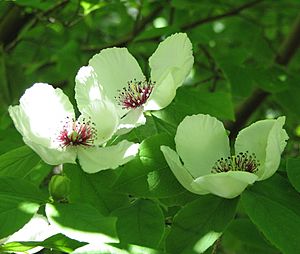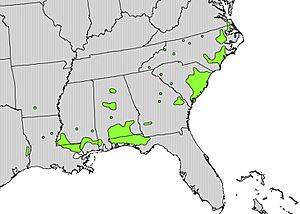Silky camellia facts for kids
Quick facts for kids Silky camellia |
|
|---|---|
 |
|
| Conservation status | |
| Scientific classification | |
| Genus: |
Stewartia
|
| Species: |
malacodendron
|
 |
|
| Natural range | |
Meet the Silky Camellia, also known as Stewartia malacodendron, the silky stewartia, or Virginia stewartia. This beautiful flowering plant belongs to the Theaceae family, which is the same family as tea plants!
The Silky Camellia grows slowly. It can become a large deciduous shrub (a bush that loses its leaves) or a small tree. It usually reaches about 3 to 4.5 meters (10 to 15 feet) tall, but some can grow as tall as 9 meters (30 feet)! You can find this plant naturally in the southeastern United States.
Its Latin name, malacodendron, means "soft tree." The common name "silky camellia" describes its flowers, which look and feel a lot like the flowers of its relatives, the Camellias.
Contents
What Does the Silky Camellia Look Like?
The Silky Camellia is a woodland plant that often grows under taller trees. It has rich brown bark. Its young stems are covered in fine hairs. The branches usually grow out sideways from the main stem, with leaves appearing on shorter stems that branch off horizontally.
Leaves and Flowers
The leaves are dark green and grow in an alternating pattern along the stem. They are about 5 to 10 centimeters (2 to 4 inches) long. Their edges are slightly toothed and covered with fine hairs, especially on the underside veins. The leaves are oval-shaped with pointed tips.
The flowers are very showy and measure about 6 to 9 centimeters (2.4 to 3.5 inches) wide. Each flower has five white petals. In the center, you'll see many stamens with purple threads and blue tips (called anthers). These fill the middle of the flat, cup-shaped flower.
Flowers grow one by one from where the leaves meet the stem, on short stalks. They have five green sepals, which are small leaf-like parts that protect the bud. In the northern parts of its range, the Silky Camellia blooms in July and August. In the southern areas, it blooms earlier, in April.
Seeds and Fruits
After the flowers bloom, the plant produces round, woody seed capsules. Each capsule has 4 to 5 sections, and if fertilized, each section holds 2 to 4 seeds. The seeds are shiny, without wings, and have an oval shape. They are purplish to reddish-brown and measure about 5 to 7 millimeters long and 4 to 6 millimeters wide.
Where Does the Silky Camellia Grow?
The Silky Camellia is native to several states in the southeastern United States. It is rare in Texas, found only in a small area near Burkeville, growing along streams, ravines, and wooded bluffs where the soil drains well.
You can also find it in scattered places in Arkansas, Georgia, the Florida panhandle, Louisiana, southern Alabama, and as far north as Virginia. This tree is listed as endangered in the US states of Arkansas and Florida, meaning it's at risk of disappearing.
Growing Silky Camellia Plants
Growing Silky Camellia plants can be a bit tricky! They grow slowly and are hard to move once they start growing. It's also a challenge to make new plants from them. They grow best in places with some shade and in soil that drains water well.
People have been growing Stewartia malacodendron in the United States since 1752. It is also grown in parks and gardens in other temperate (mild climate) parts of the world. In the UK, it has even won the Royal Horticultural Society's Award of Garden Merit, which means it's a great plant for gardens!


